The Design of Cement Mortar with Low Capillary Suction: Understanding the Effect of Fine Aggregate and Sodium Silicate
Abstract
:1. Introduction
2. Materials and Methods
2.1. Basalt Fine Aggregate
2.2. Cement
2.3. Sodium Silicate
2.4. Determination of the Capillary Suction of the Fine Aggregate
2.5. Preparation of Cement Mortar Bars
2.6. Determination of the Capillary Suction of the Cement Masonry Mortar
3. Results
3.1. The Capillary Suction of the Basalt Fine Aggregate
3.2. The Capillary Suction of the Cement Masonry Mortars
4. Conclusions
- As a result of the research, it was found that the M15 cement mortar with the fine basalt aggregate and more sodium silicate had the lowest rate of capillary suction. The reason for this was the sodium silicate added to the cement mortar. The amount of aggregate added to the cement mortar is also important. When compared to the M5 and M10 mortars, the M15 mortar contains the smallest amount of fine aggregate.
- Tests of the capillary suction showed that the M5 mortar, in comparison to the M10 and M15 mortars, had the highest rate of capillary suction. The reason for this was the proportions of the components that were used in the mortar when compared to the M10 and M15 mortars.
- In the case of the M10 mortar, the best result was obtained by the bar made of the cement mortar with basalt fine aggregate and more sodium silicate, while in the case of the M15 mortar, the best result was obtained by the bar with basalt fine aggregate and more sodium silicate. The reason for this was the sodium silicate added to the cement mortar.
- An important element that enabled a favorable result to be obtained was sodium silicate. This, as shown by the research, made it possible to reduce water absorption.
Author Contributions
Funding
Data Availability Statement
Conflicts of Interest
References
- Hoła, A. Methodology for the in situ testing of the moisture content of brick walls: An example of applica-tion. Arch. Civ. Mech. Eng. 2020, 20, 114. [Google Scholar] [CrossRef]
- Nowogońska, B. Consequences of Abandoning Renovation: Case Study—Neglected Industrial Heritage Building. Sustainability 2020, 12, 6441. [Google Scholar] [CrossRef]
- Bajno, D.; Bednarz, Ł.; Nowak, T. Problems relating to assessment, repair and restoration of wooden roof structures in historic buildings, as exemplified by two case studies in southern Poland. Adv. Mater. Res. 2013, 778, 888–894. [Google Scholar] [CrossRef]
- De Freitas, V.P.; Torres, I.; Guimarães, A.S. Rising Damp—Technical Note; FEUP: Porto, Portugal, 2008. [Google Scholar]
- Groot, C.J.W.P. Effects of Water on Mortar-Brick Bond; Delft University of Technology: Delft, The Netherlands, 1993. [Google Scholar]
- Oliver, A. Dampness in Buildings; BSP Professional Books: Oxford, UK, 1988; ISBN 0-632-01932-8. [Google Scholar]
- Jasieńko, J.; Nowak, T.; Bednarz, Ł. Wrocław University’s Leopoldinum Auditorium–Tests of Its Ceiling and a Conservation and Strengthening Concept. Adv. Mater. Res. 2010, 133, 265–270. [Google Scholar] [CrossRef]
- Nodehi, M.; Ozbakkaloglu, T.; Gholampour, A.; Mohammed, T.; Shi, X. The effect of curing regimes on physico-mechanical, microstructural and durability properties of alkali-activated materials: A review. Constr. Build. Mater. 2022, 321, 126335. [Google Scholar] [CrossRef]
- ASTM C1585-13; Standard Test Method for Measurement of Rate of Absorption of Water by Hydraulic Cement Concretes. ASTM: West Conshohocken, PA, USA, 2004.
- Nodehi, M.; Taghvaee, V. MAlkali-activated materials and geopolymer: A review of common precursors and activators addressing circular economy. Circ. Econ. Sustain. 2021, 6, 1–32. [Google Scholar]
- Knarud, J.; Geving, S.; Kvande, T. Experimental Investigation of Capillary Absorption Along Mortar-Brick Interface Plane. In Proceedings of the Central European Symposium on Building Physics, Dresden, Germany, 16 September 2016. [Google Scholar]
- Guimarãesa, A.S.; de Freitasa, V.P.; Delgadoa, J.M.P.Q.; Regoa, T. The Interface Effect in the Water Absorption in Ceramic Brick. Energy Procedia 2015, 78, 1395–1400. [Google Scholar] [CrossRef] [Green Version]
- Castro Mendes, J.; Pinto, P.B.; da Silva Américo, H.E.; Barreto, R.R.; Moro, T.K.; Fiorotti Peixoto, R.A. Macroporous Mortars for Laying and Coating. Rev. Construcción. J. Constr. 2019, 18, 29–41. [Google Scholar] [CrossRef]
- Lanzón, M.; García-Ruiz, P.A. Evaluation of capillary water absorption in rendering mortarsmade with powdered waterproofi ng additives. Constr. Build. Mater. 2009, 23, 3287–3291. [Google Scholar] [CrossRef]
- Veiga, M.; Magalhães, A.; Bokan-Bosilikov, V. Capillarity tests on historic mortar samples extracted from site methodology and compared results. In Proceedings of the 13th International Brickand Block Masonry Conference Amsterdam, Amsterdam, The Netherlands, 4–7 July 2004. [Google Scholar]
- Xiao, Q.; Liu, X.; Qiu, J.; Li, Y. Capillary Water Absorption Characteristics of Recycled. Concrete in Freeze-Thaw Environment. Adv. Mater. Sci. Eng. 2020, 2020, 1620914. [Google Scholar] [CrossRef]
- Rirsch, E.; Zhang, Z. Rising Damp in Masonry Walls and the Importance of Mortar Properties. Constr. Build. Mater. 2010, 24, 1815–1820. [Google Scholar] [CrossRef]
- Belleghem, V.; Montoya, R.; Dewanckele, J.; Van den Steen, N.; De Graeve, I.; Deconinck, J.; Cnudde, V.; Van Tittelboom, K.; De Belie, N. Capillary water absorption in cracked and uncracked mortar –A comparison between experimental study and finite element analysis. Constr. Build. Mater. 2016, 110, 154–162. [Google Scholar] [CrossRef]
- Morón, C.; Ferrández, D.; Saiz, P.; Yedra, E. Measuring system of capillary rising damp in cement mortars. Measurement 2019, 135, 252–259. [Google Scholar] [CrossRef]
- Vicario, I.; Sáiz, Á.; Cuadrado, J.; Petrement, C.; González, S. The influence of porosity on the behaviour in humid enviroments of mortars made with steelmaking slags and additives. DYNA 2017, 92, 220–225. [Google Scholar]
- Rymarczyk, T.; Kłosowski, G.; Hoła, A.; Sikora, J.; Wołowiec, T.; Tchórzewski, P.; Skowron, S. Comparison of machine learning methods in electrical tomography for detecting moisture in building walls. Energies 2021, 14, 2777. [Google Scholar] [CrossRef]
- Hanzic, L.; Kosec, L.; Anzel, I. Capillary absorption in concrete and the Lucas-Washburn equation. Cem. Concr. Compos. 2010, 32, 84–91. [Google Scholar] [CrossRef]
- Oliveira, L. Metodologia Para o Desenvolvimento de Fachadas Leves; Escola Politécnica da Universidade de São Paulo: São Paulo, Brazil, 2009. [Google Scholar]
- Polanco, J.A.; Manso, J.M.; Setién, J.; González, J.J. Strength and durability of concrete made with electric steelmaking slag. ACI Mater. J. 2011, 108, 196–203. [Google Scholar]
- Qiu, X. Moisture Transport Across Interfaces between Building Materials. Ph.D. Thesis, Concordia University, Montreal, QC, Canada, 2003. [Google Scholar]
- Quan, Q.; Li, H.; Qin, Y. Recycled Aggregate for Concrete; China Construction Industry Press: Beijing, China, 2011. [Google Scholar]
- Veiga, M.R. Protecção contra a água de paredes de edifícios antigos. Avaliação experimental da capacidade de protecção de argamassas de reboco com base em cal. In Proceedings of the Encontro Nacional sobre Conservação e Reabilitação de Estruturas—REPAR2000, Lisbon, Portugal, 14–17 June 2000. [Google Scholar]
- Szemiot, N. Wpływ domieszki szkła wodnego na podciąganie kapilarne zapraw cementowych. Mater. Bud. 2021, 11, 39–40. [Google Scholar] [CrossRef]
- Available online: https://www.gorazdze.pl/pl/cement-portlandzki-pn-en-197-1-cem-i-425r (accessed on 11 October 2021).
- Chajec, A. Granite Powder vs. Fly Ash for the Sustainable Production of Air-Cured Cementitious Mortars. Materials 2021, 14, 1208. [Google Scholar] [CrossRef] [PubMed]
- Available online: http://chempur.pl/pliki/karty_charakterystyk/szklo_wodne_sodowe.pdf (accessed on 11 October 2021).
- Wysocka, M.; Szypcio, Z.; Tymosiak, D. Prędkość wznoszenia kapilarnego w gruntach niespoistych. Politech. Białostocka 2013, 4, 167–172. [Google Scholar]
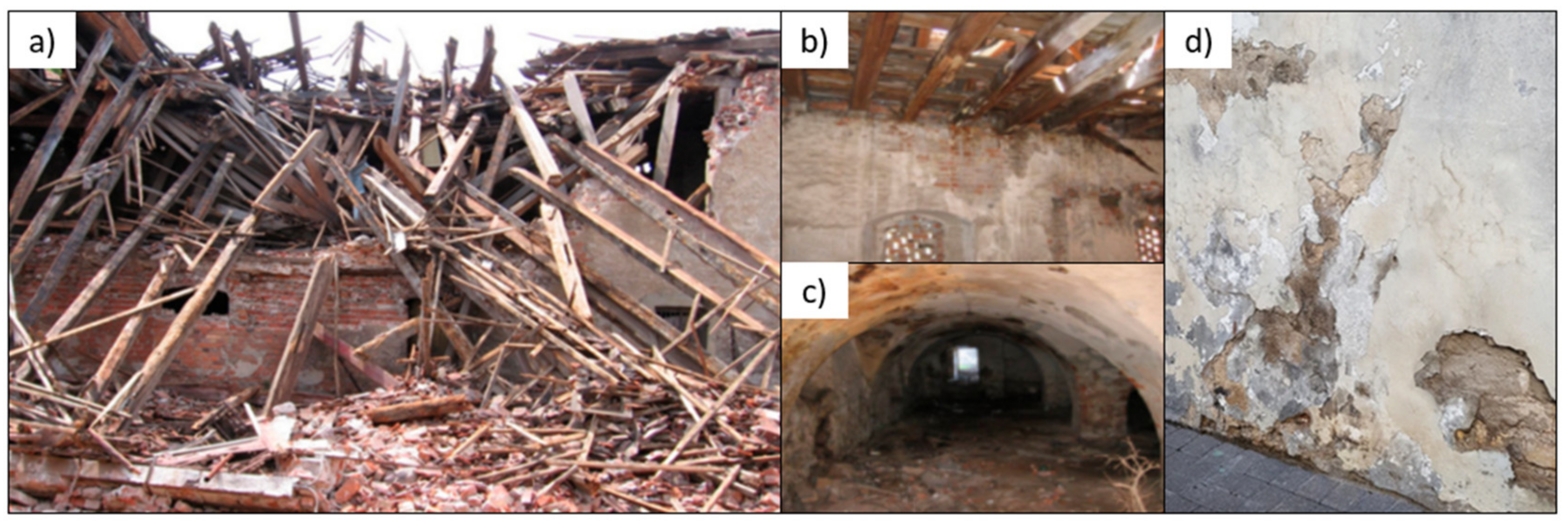
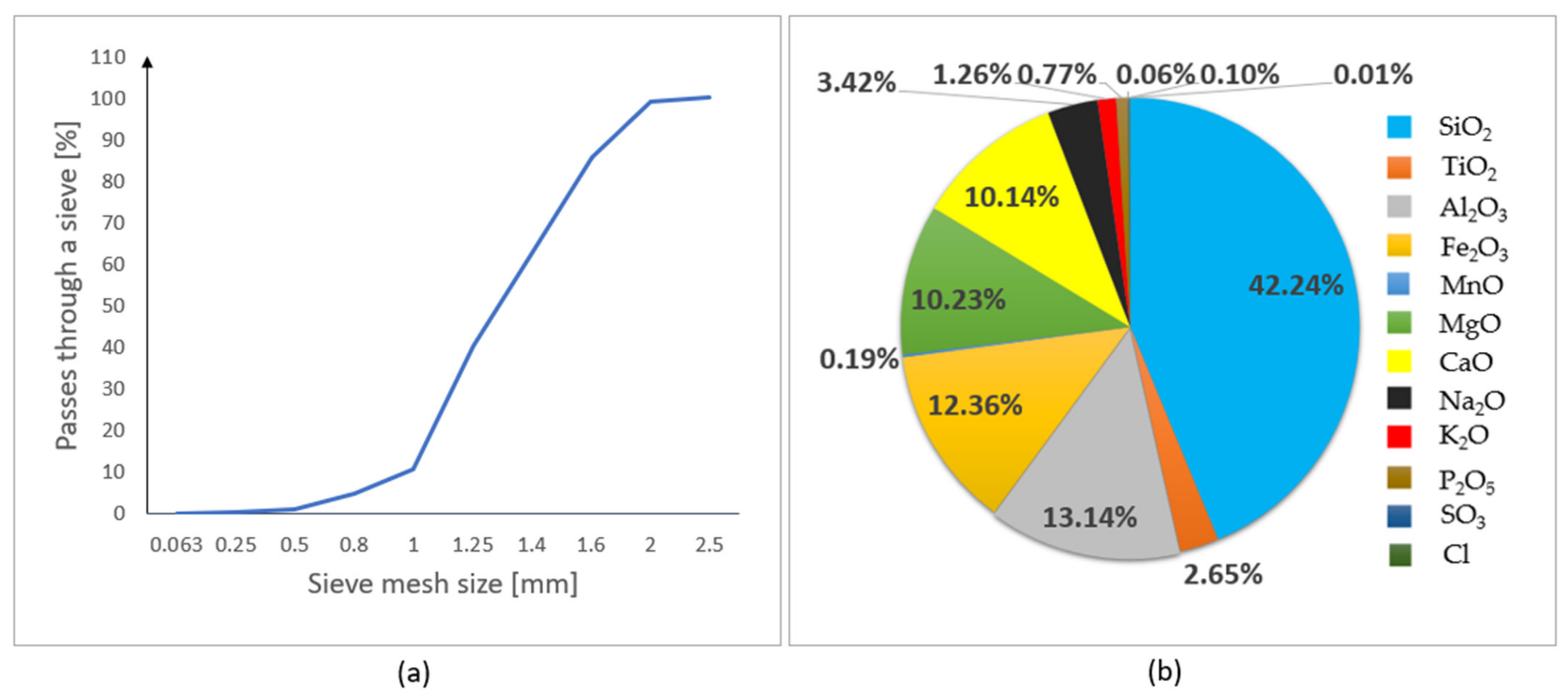

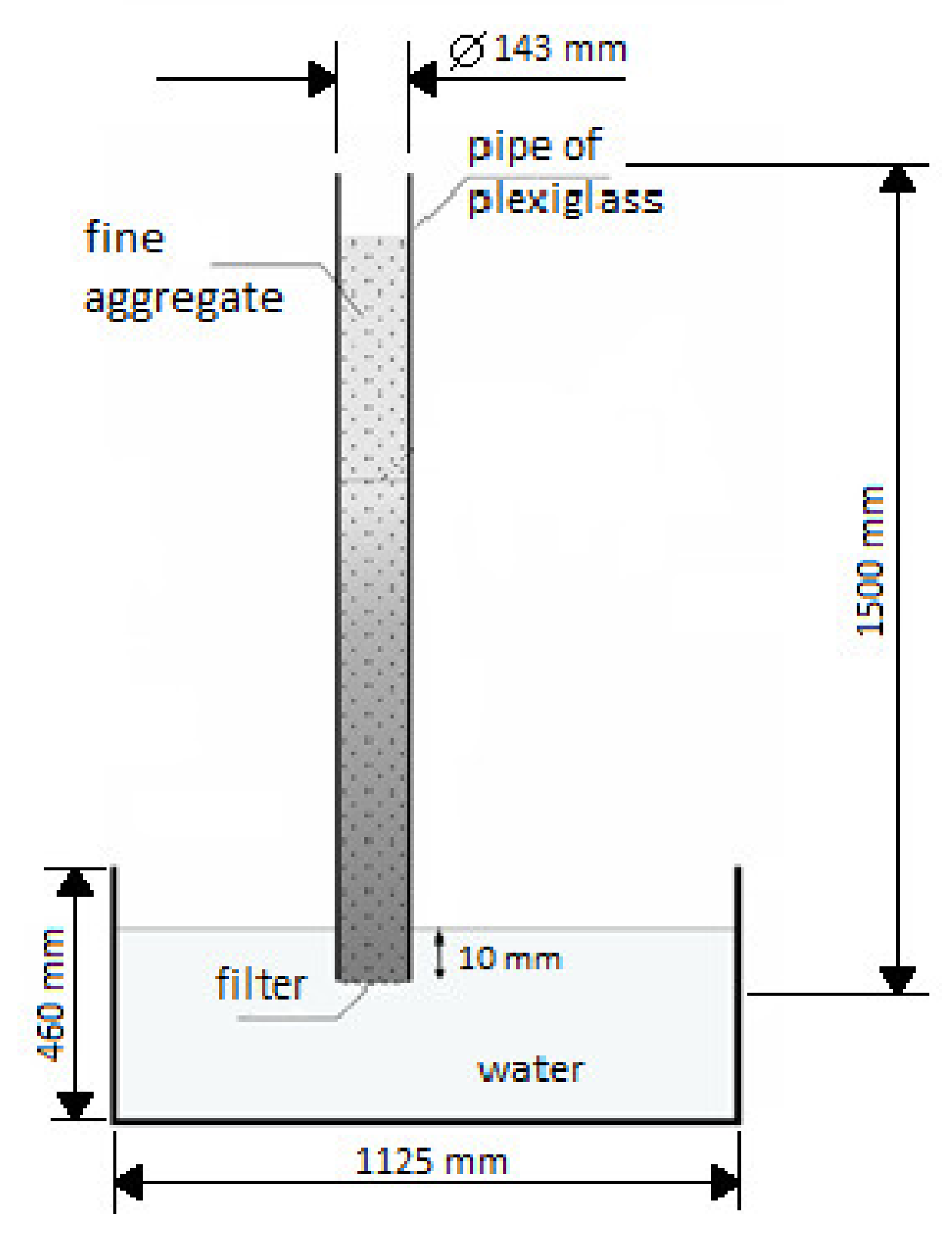

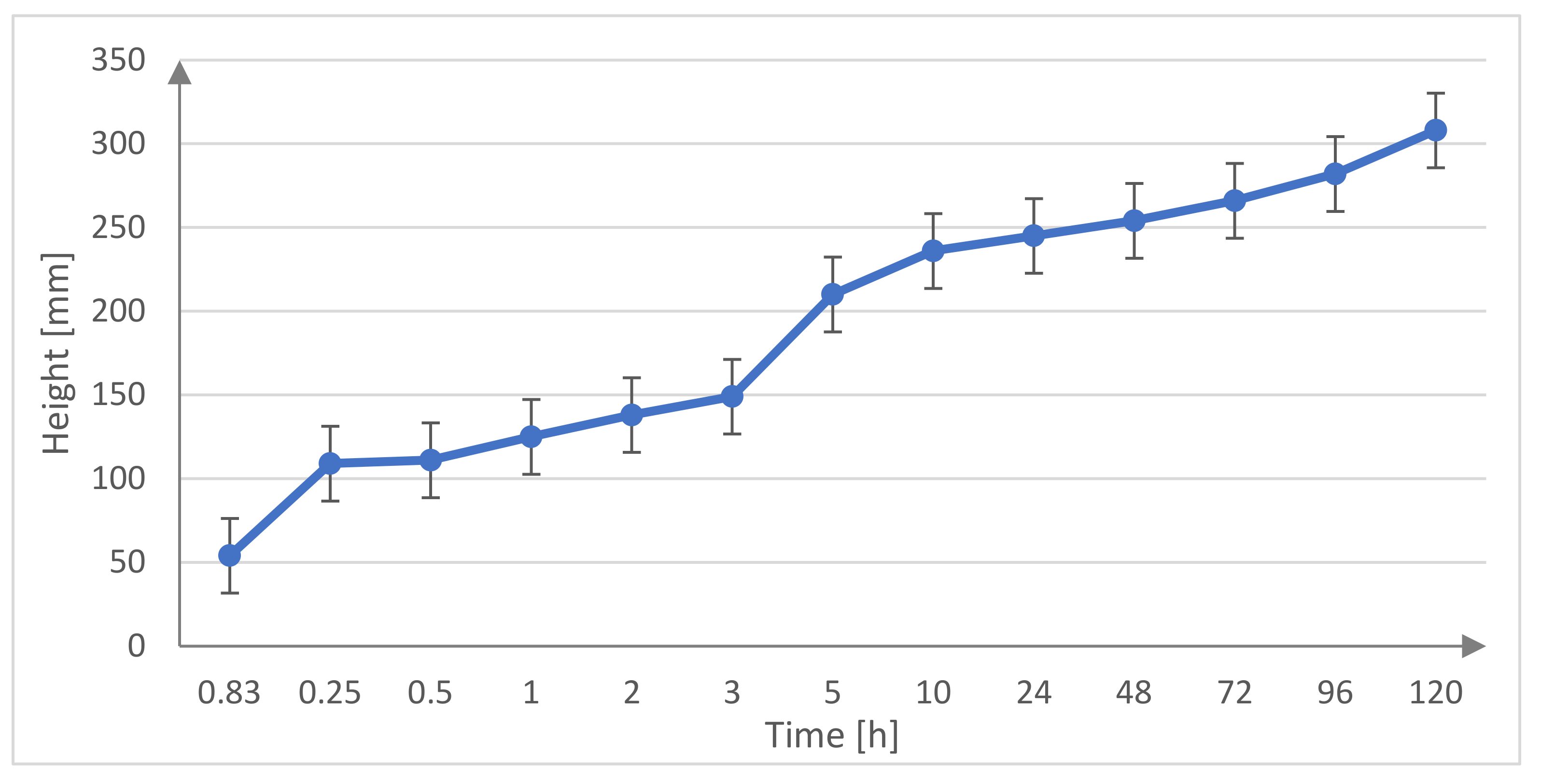
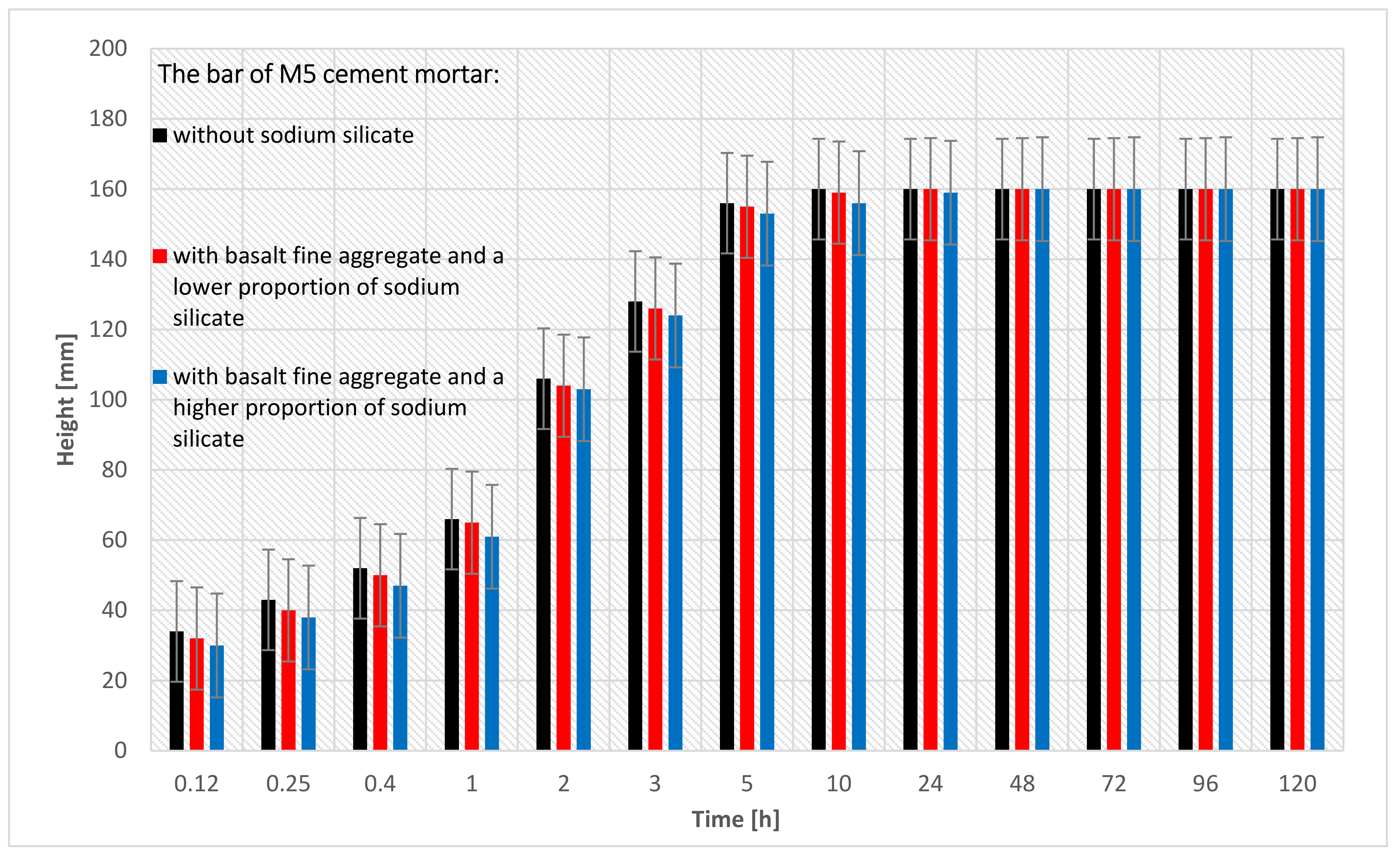
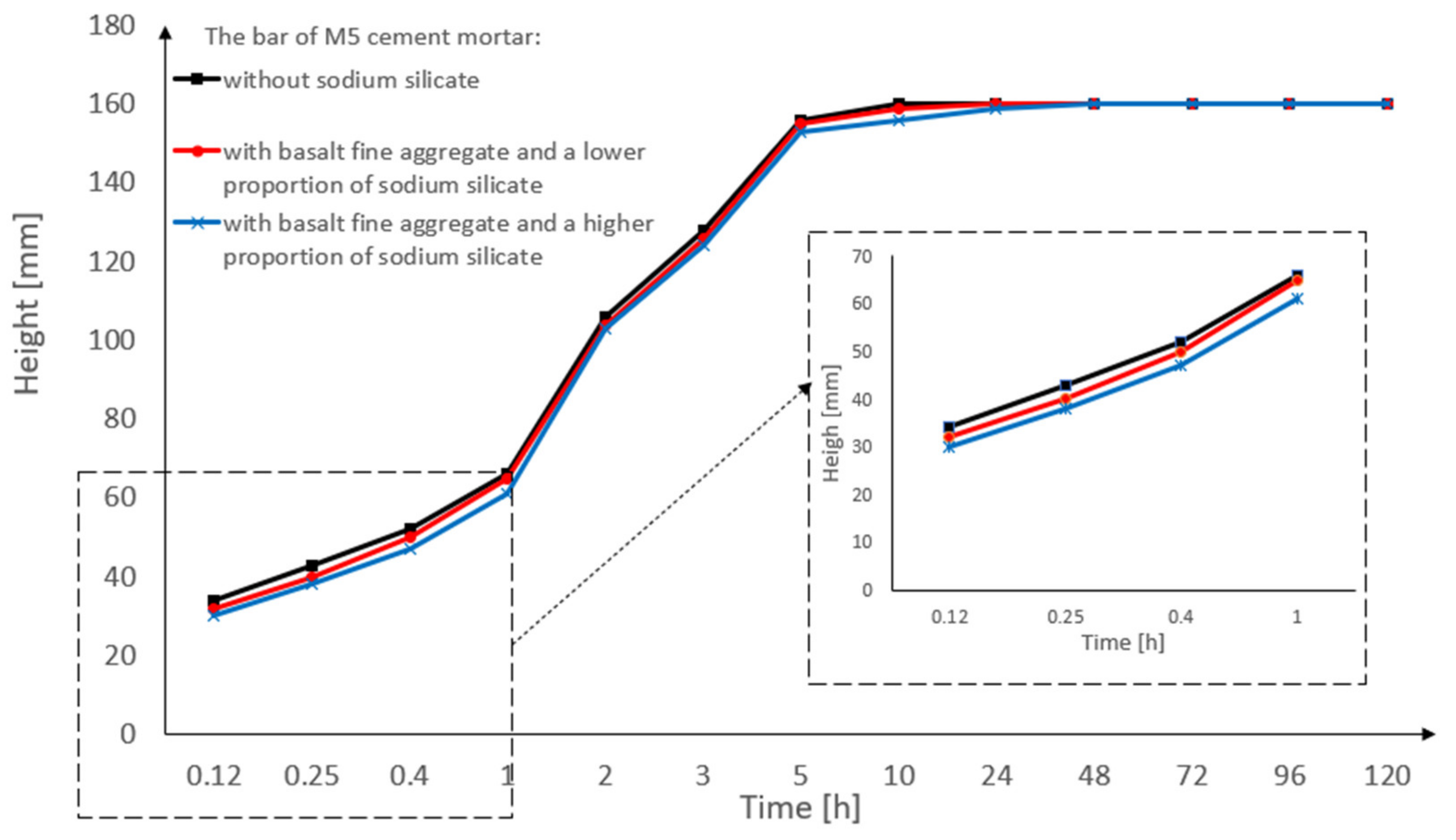
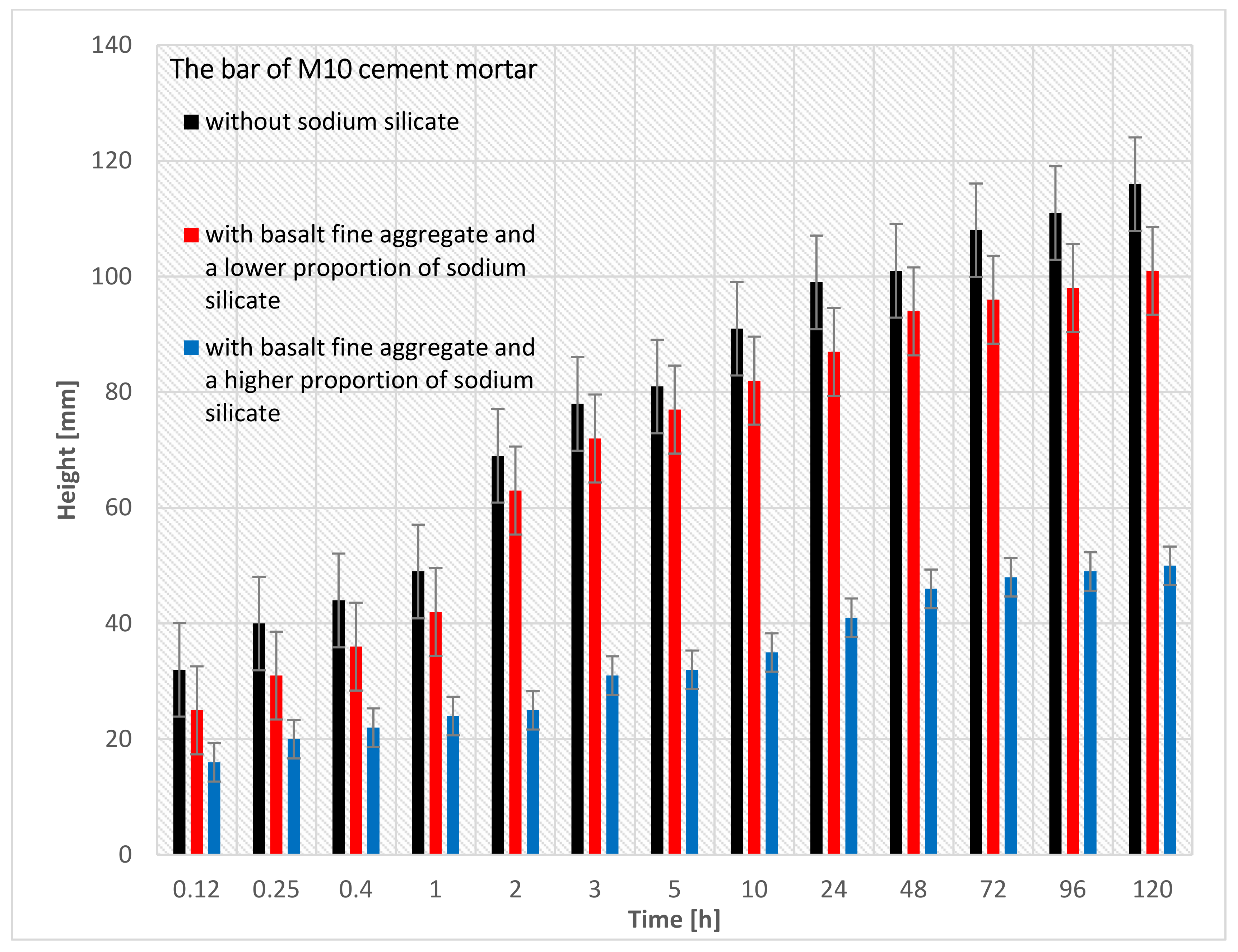

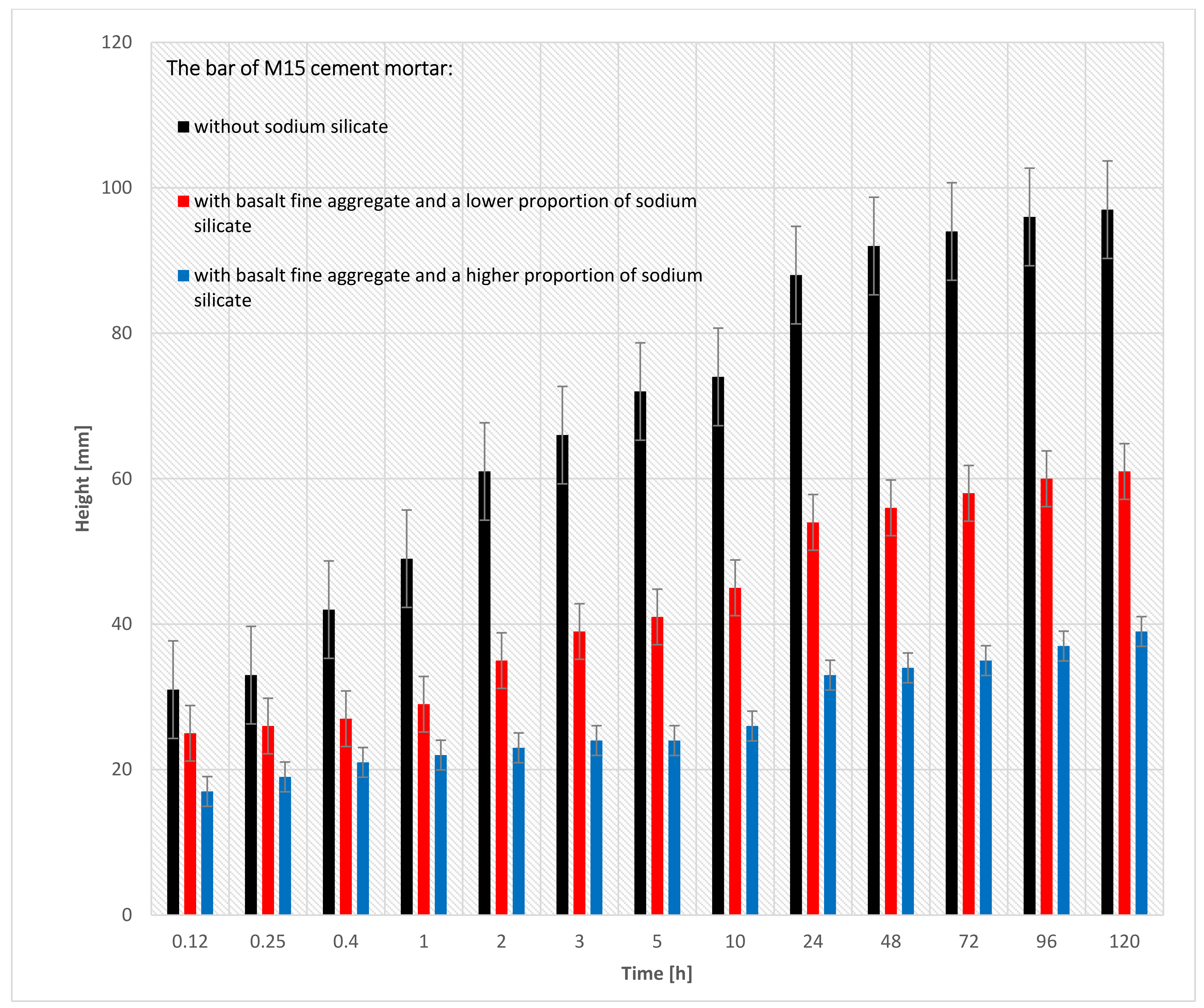
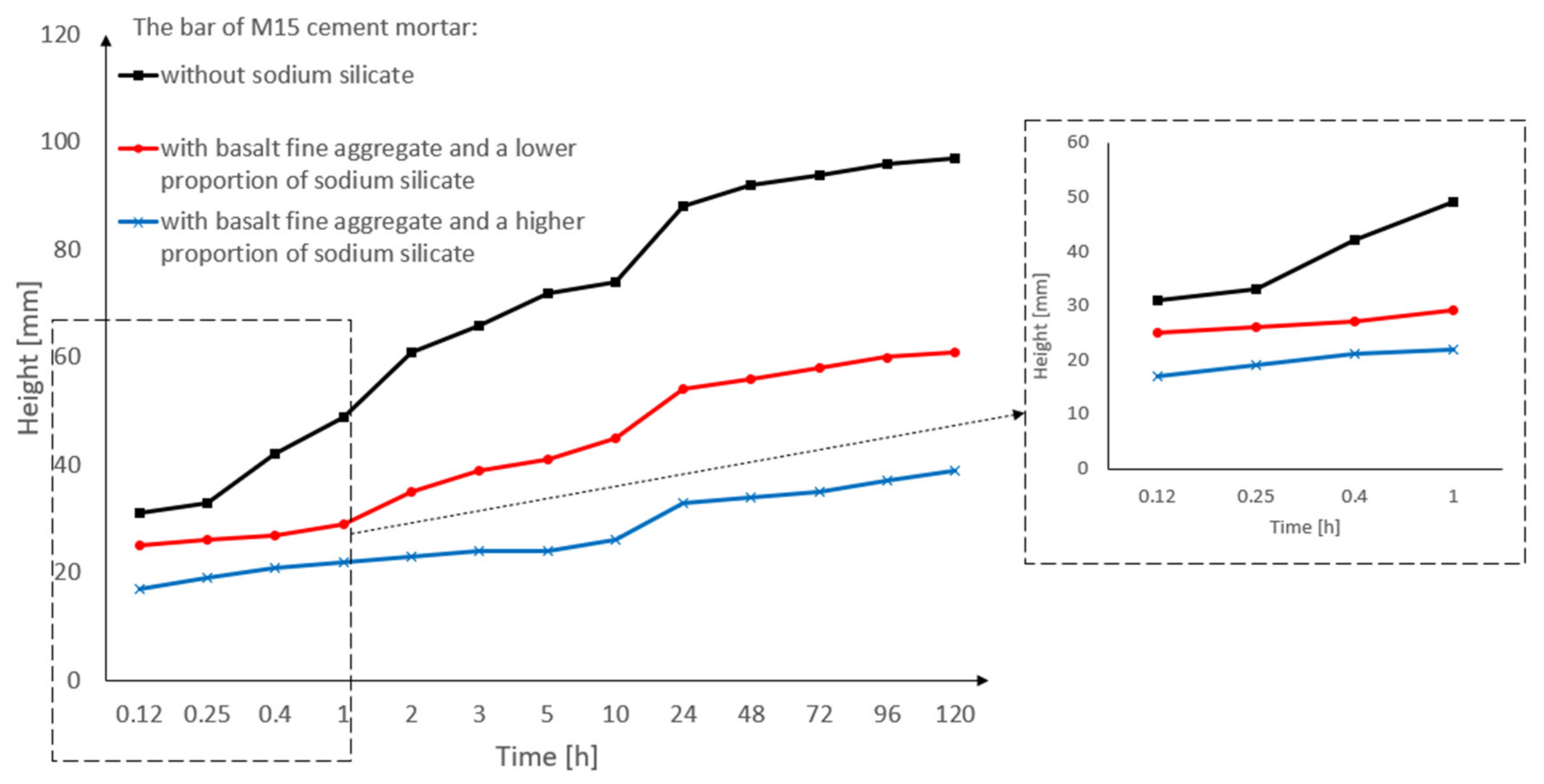

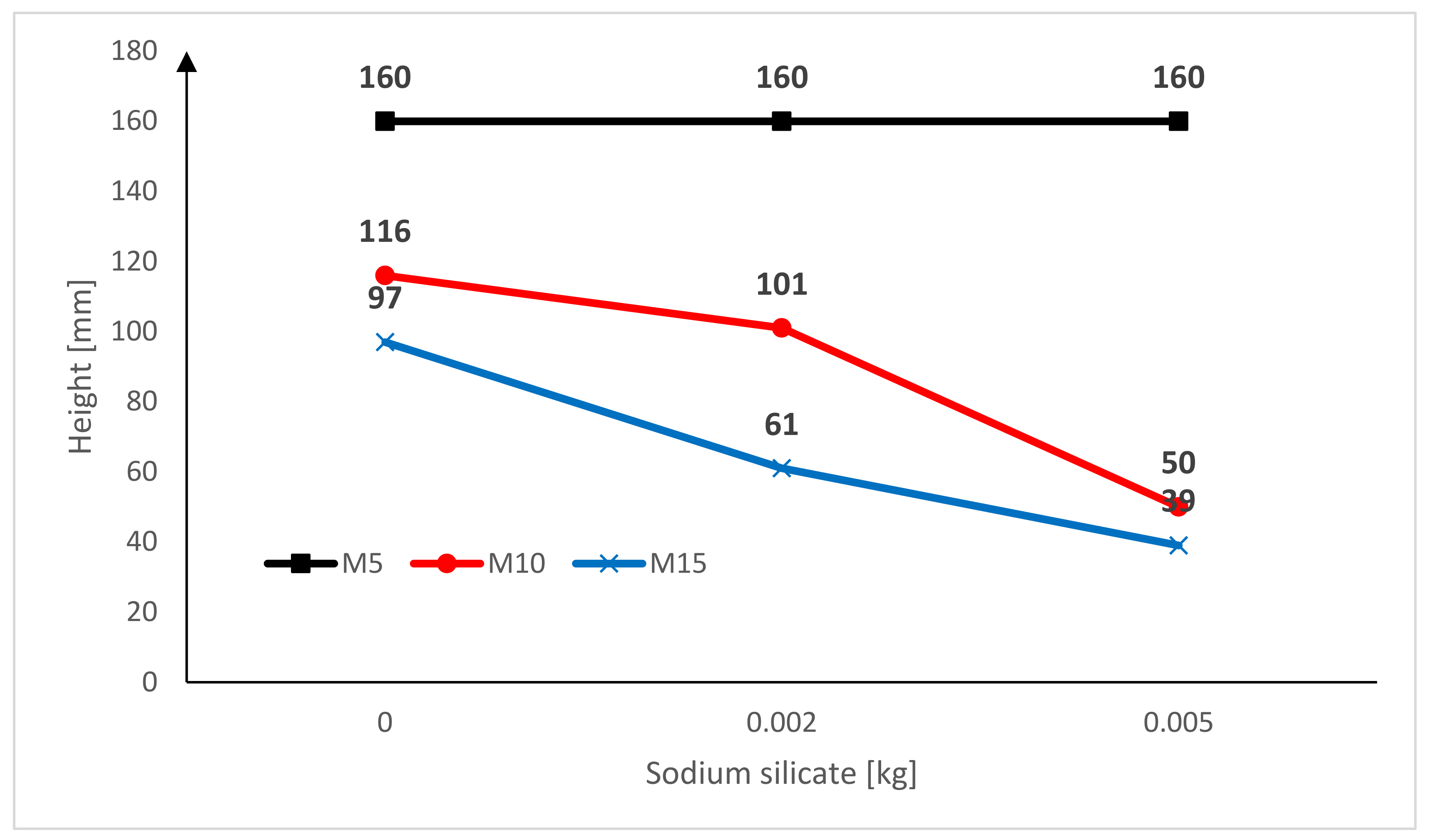
| No. | Author | Main Findings |
|---|---|---|
| 1 | Knarud et al. [11] | When tested with their face down, it was found that pillar specimens (consisting of three bricks with mortar joints) had higher water absorption coefficients than individual bricks for all test series. |
| 2 | Guimarãesa et al. [12] | The results of the experimental campaign of absorption in samples of clay brick with and without joints, and also clay brick with joints with different contact configurations showed that when moisture reaches the interface there is a slowing of the wetting process due to the hygric resistance of the interface. |
| 3 | Castro Mendes et al. [13] | Macropores are advantageous in the case of lightweight mortars with smaller thermal conductivity, water absorption and capillarity. The decrease in the inlet of water leads to a smaller chance of moisture problems. |
| 4 | Lanzón et al. [14] | Powdered silicone and sodium oleate showed the best resistance to water penetration, while metallic soaps in the form of calcium stearate and zinc stearate showed the lowest efficiency at low dosages. |
| 5 | Veiga et al. [15] | The old lime mortars studied in the research had capillarity coefficients that are similar to new lime mortars (between 90 and 10 min). However, they had much slower absorptions during the first few minutes. This means that the absorption rate of old mortars remains almost constant during the first 90 min, while new mortars have a much higher rate of absorption during the first few minutes, after which they stabilize. |
| 6 | Xiao et al. [16] | The results showed that when the freeze–thaw environment is the same, the replacement rate of the recycled coarse aggregate is faster, the cumulative water absorption by the RAC is greater, and the initial water absorption (capillary rise) is faster. When the freeze–thaw environment is different, there are more freeze–thaw cycles, the accumulated water absorption (capillary rise) by the RAC at the same replacement rate of recycled coarse aggregate is greater, and the initial water absorption (capillary rise) is faster. |
| 7 | Rirsch et al. [17] | It was found that the characteristics of mortar considerably affect the height of rising damp. Additionally, a strong correlation between rising damp and the Sharp Front Model was observed. It was also found that the rate of absorption of water into the mortar is a crucial factor in determining the height of the rising damp. |
| 8 | Belleghem et al. [18] | The entrance of capillary water into the mortar (cracked and uncracked) was simulated using the 3D Richards equation together with the finite element method (FEM). The developed model was characterized by realistic boundary conditions of the process of water evaporation. The model was validated using gravimetrical water absorption and X-ray radiography. |
| 9 | Morón et al. [19] | According to the results of the studies, recycled mortars show a higher water absorption during capillary action due to the larger capillary system formed in this type of mortar (as a result of the high absorption of recycled aggregates). |
| 10 | Santamaría-Vicario et al. [20] | The results of the study indicate that the joint use of both steelmaking slags and additives enables the production of masonry mortars with low water absorption by capillarity index, with water vapor permeability being high. Mortars made with EAFS and LFS slags need additives in order to retain mixing water and to ensure their correct setting and hardening. |
| Name of Property | Unit | Average Value | Requirement |
|---|---|---|---|
| Setting time | (min) | 251 | ≥60 |
| Consistency | (%) | 27.4 | No requirements |
| Specific surface area | (cm2/g) | 3655 | No requirements |
| Content of SO3 | (%) | 2.76 | ≤4.0% |
| Content of Cl− | (%) | 0.045 | ≤0.10% |
| Content of Na2Oeq | (%) | 0.50 | No requirements |
| Appearance: | White, colorless or semi-translucent liquid |
| Odor: | Odorless |
| pH: | 11–13 in a temperature of 20 °C |
| Melting point/pour point [°C]: | For a pure substance: Softening point 550–670 °C Pour point 730–870 °C |
| Flash point: | Non-flammable substance |
| Upper/lower flammability/explosive limits: | Research is not necessary—non-flammable substance |
| Explosive properties: | Research is not necessary—inorganic substance |
| Breakdown temperature: | No data—the substance does not decompose at temperatures below 1400 °C |
| Solubility: | Sodium silicate water solution—sodium silicate is mixed with water in any ratio. |
| No. | Cement (kg) | Water (kg) | Fine Aggregate (kg) | Sodium Silicate (kg) |
|---|---|---|---|---|
| M5 cement mortar | ||||
| 3 | 0.5 | 0.48 | 3.5 | 0 |
| 6 | 0.5 | 0.48 | 3.5 | 0.002 |
| 9 | 0.5 | 0.48 | 3.5 | 0.005 |
| M10 cement mortar | ||||
| 13 | 0.5 | 0.44 | 2.86 | 0 |
| 16 | 0.5 | 0.44 | 2.86 | 0.002 |
| 19 | 0.5 | 0.44 | 2.86 | 0.005 |
| M15 cement mortar | ||||
| 23 | 0.5 | 0.34 | 2.14 | 0 |
| 26 | 0.5 | 0.34 | 2.14 | 0.002 |
| 29 | 0.5 | 0.34 | 2.14 | 0.005 |
| Basalt Fine Aggregate | ||||
|---|---|---|---|---|
| h (mm) | ||||
| Time | Sample 1 | Sample 2 | Sample 3 | Average |
| 5 min. | 54 | 56 | 56 | 55.33 |
| 15 min. | 109 | 113 | 112 | 111.33 |
| 30 min. | 111 | 116 | 116 | 114.33 |
| 1 h | 125 | 128 | 127 | 126.67 |
| 2 h | 138 | 141 | 142 | 140.33 |
| 3 h | 149 | 156 | 159 | 154.67 |
| 5 h | 210 | 214 | 213 | 212.33 |
| 10 h | 236 | 240 | 239 | 238.33 |
| 24 h | 245 | 249 | 247 | 247.00 |
| 48 h | 254 | 258 | 255 | 255.67 |
| 72 h | 266 | 270 | 271 | 269.00 |
| 96 h | 282 | 286 | 286 | 284.67 |
| 120 h | 308 | 315 | 314 | 312.33 |
Publisher’s Note: MDPI stays neutral with regard to jurisdictional claims in published maps and institutional affiliations. |
© 2022 by the authors. Licensee MDPI, Basel, Switzerland. This article is an open access article distributed under the terms and conditions of the Creative Commons Attribution (CC BY) license (https://creativecommons.org/licenses/by/4.0/).
Share and Cite
Szemiot, N.; Sadowski, Ł. The Design of Cement Mortar with Low Capillary Suction: Understanding the Effect of Fine Aggregate and Sodium Silicate. Materials 2022, 15, 1517. https://doi.org/10.3390/ma15041517
Szemiot N, Sadowski Ł. The Design of Cement Mortar with Low Capillary Suction: Understanding the Effect of Fine Aggregate and Sodium Silicate. Materials. 2022; 15(4):1517. https://doi.org/10.3390/ma15041517
Chicago/Turabian StyleSzemiot, Natalia, and Łukasz Sadowski. 2022. "The Design of Cement Mortar with Low Capillary Suction: Understanding the Effect of Fine Aggregate and Sodium Silicate" Materials 15, no. 4: 1517. https://doi.org/10.3390/ma15041517






